 Database
Database
 Mysql Tutorial
Mysql Tutorial
 Reduce storage of MySQL RDS databases with zero downtime using AWS Blue/Green deployment
Reduce storage of MySQL RDS databases with zero downtime using AWS Blue/Green deployment
Reduce storage of MySQL RDS databases with zero downtime using AWS Blue/Green deployment
DevOps engineers often face the challenges of RDS database optimization and update, especially in high load situations, where traditional methods are prone to risk of downtime. This article introduces AWS blue/green deployment strategy to achieve zero downtime update of RDS database.
Say goodbye to the nightmare of database update downtime! This article will explain the blue/green deployment strategy in detail and provide operational steps in the AWS environment to help you update the RDS database instance without affecting service availability.
Preparation
First, coordinate the development team and select the period with the lowest workload traffic for updates. Good DevOps practice advice to notify the team in advance.
This example demonstrates how to reduce database instance storage space with zero downtime using blue/green deployment. You can operate through the AWS RDS console, the AWS CLI, or the AWS SDK, which is used by the AWS RDS console .
Note: Always enable automatic backup before performing a blue/green deployment for a MySQL or MariaDB RDS instance.
Step 1: Create a blue/green deployment
Assuming that the database cluster contains one primary database and three replicas (as shown in the figure below), we reduce the primary database storage space from 400GB to 200GB.

Select the main database, click "Action", and then select "Create Blue/Green Deployment" to enter the blue/Green Deployment configuration interface.
Step 2: Specify the identifier
Specify a unique identifier name for the blue/green deployment (case insensitive, but stored in lower case). This identifier is used to distinguish between production environments (blue environment) and temporary environments (green environment).
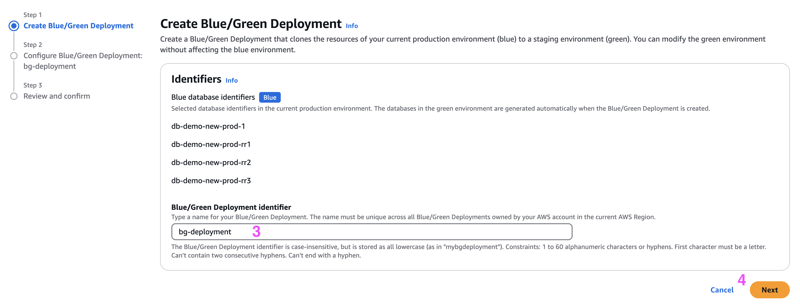
Step 3: Configure a green environment
Configure the database engine and parameter group for the green environment. In this example, to reduce storage space, we use the same engine version and parameter group as in the Blue Environment (production database).
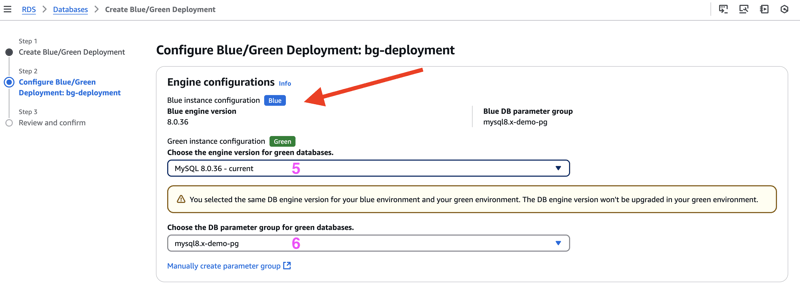
Step 4: Configure the green instance database type
Select the same instance type as the blue environment.
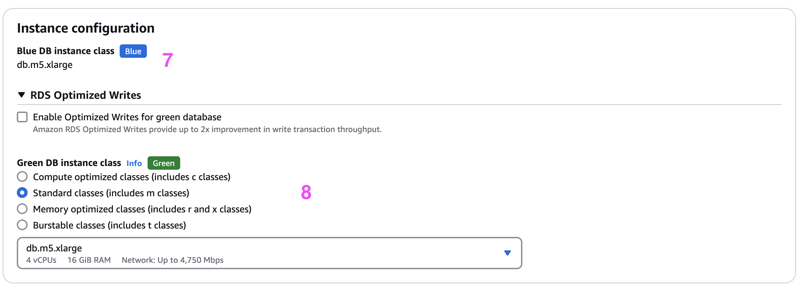
Step 5: Adjust the green environment storage space
Key Steps: Resize the storage space of the green deployment to the target size (200GB in this example).
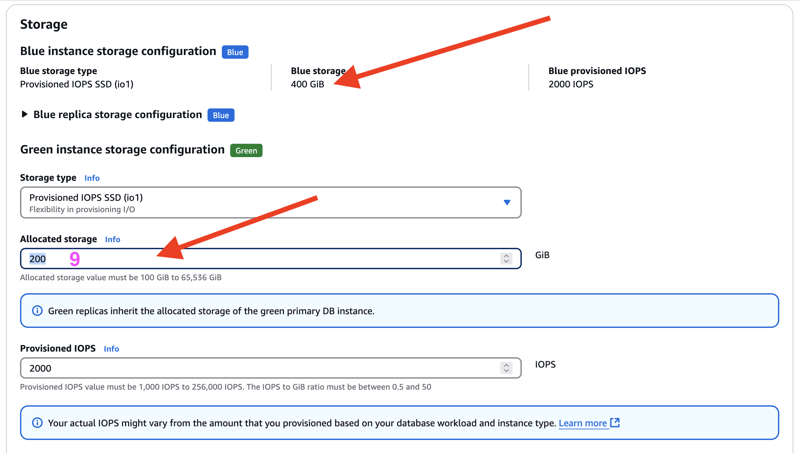
The AWS console will synchronously update the entire database cluster. Note that what we're reducing the storage space of the primary database, and this change will be applied to all three replicas.
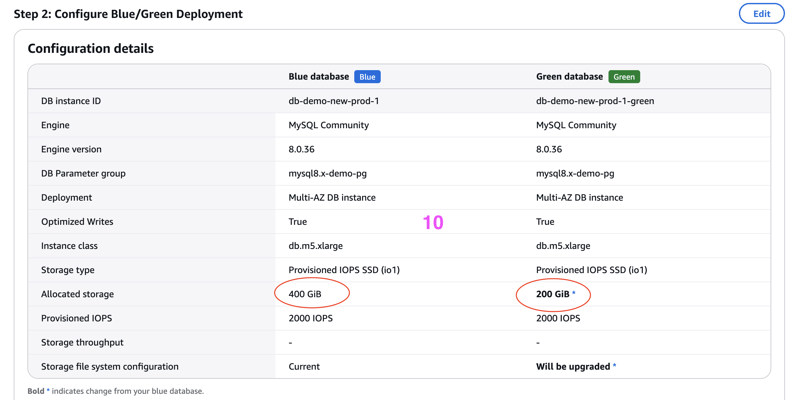 (Comparison of blue and green main deployment)
(Comparison of blue and green main deployment)
 (Comparison of blue and green copy)
(Comparison of blue and green copy)
Before clicking "Create", the system will display the cost estimate for green deployment.

The completion time of a blue/green deployment depends on factors such as database size, workload, and replica count, and can take several minutes to several hours. In this case, it takes about 5 hours.
AWS automatically handles green deployed database cluster naming conventions to align with the blue environment, including updating the endpoints of the primary and replica nodes. You do not need to modify the application configuration. It is recommended to notify the development team of this action through appropriate channels (such as Slack). The entire process achieves zero downtime, with short delays only on the main cluster (blue) environment.
The above is the detailed content of Reduce storage of MySQL RDS databases with zero downtime using AWS Blue/Green deployment. For more information, please follow other related articles on the PHP Chinese website!

Hot AI Tools

Undresser.AI Undress
AI-powered app for creating realistic nude photos

AI Clothes Remover
Online AI tool for removing clothes from photos.

Undress AI Tool
Undress images for free

Clothoff.io
AI clothes remover

AI Hentai Generator
Generate AI Hentai for free.

Hot Article

Hot Tools

Notepad++7.3.1
Easy-to-use and free code editor

SublimeText3 Chinese version
Chinese version, very easy to use

Zend Studio 13.0.1
Powerful PHP integrated development environment

Dreamweaver CS6
Visual web development tools

SublimeText3 Mac version
God-level code editing software (SublimeText3)

Hot Topics
 1381
1381
 52
52
 MySQL: Simple Concepts for Easy Learning
Apr 10, 2025 am 09:29 AM
MySQL: Simple Concepts for Easy Learning
Apr 10, 2025 am 09:29 AM
MySQL is an open source relational database management system. 1) Create database and tables: Use the CREATEDATABASE and CREATETABLE commands. 2) Basic operations: INSERT, UPDATE, DELETE and SELECT. 3) Advanced operations: JOIN, subquery and transaction processing. 4) Debugging skills: Check syntax, data type and permissions. 5) Optimization suggestions: Use indexes, avoid SELECT* and use transactions.
 How to open phpmyadmin
Apr 10, 2025 pm 10:51 PM
How to open phpmyadmin
Apr 10, 2025 pm 10:51 PM
You can open phpMyAdmin through the following steps: 1. Log in to the website control panel; 2. Find and click the phpMyAdmin icon; 3. Enter MySQL credentials; 4. Click "Login".
 MySQL: An Introduction to the World's Most Popular Database
Apr 12, 2025 am 12:18 AM
MySQL: An Introduction to the World's Most Popular Database
Apr 12, 2025 am 12:18 AM
MySQL is an open source relational database management system, mainly used to store and retrieve data quickly and reliably. Its working principle includes client requests, query resolution, execution of queries and return results. Examples of usage include creating tables, inserting and querying data, and advanced features such as JOIN operations. Common errors involve SQL syntax, data types, and permissions, and optimization suggestions include the use of indexes, optimized queries, and partitioning of tables.
 Why Use MySQL? Benefits and Advantages
Apr 12, 2025 am 12:17 AM
Why Use MySQL? Benefits and Advantages
Apr 12, 2025 am 12:17 AM
MySQL is chosen for its performance, reliability, ease of use, and community support. 1.MySQL provides efficient data storage and retrieval functions, supporting multiple data types and advanced query operations. 2. Adopt client-server architecture and multiple storage engines to support transaction and query optimization. 3. Easy to use, supports a variety of operating systems and programming languages. 4. Have strong community support and provide rich resources and solutions.
 How to use single threaded redis
Apr 10, 2025 pm 07:12 PM
How to use single threaded redis
Apr 10, 2025 pm 07:12 PM
Redis uses a single threaded architecture to provide high performance, simplicity, and consistency. It utilizes I/O multiplexing, event loops, non-blocking I/O, and shared memory to improve concurrency, but with limitations of concurrency limitations, single point of failure, and unsuitable for write-intensive workloads.
 MySQL and SQL: Essential Skills for Developers
Apr 10, 2025 am 09:30 AM
MySQL and SQL: Essential Skills for Developers
Apr 10, 2025 am 09:30 AM
MySQL and SQL are essential skills for developers. 1.MySQL is an open source relational database management system, and SQL is the standard language used to manage and operate databases. 2.MySQL supports multiple storage engines through efficient data storage and retrieval functions, and SQL completes complex data operations through simple statements. 3. Examples of usage include basic queries and advanced queries, such as filtering and sorting by condition. 4. Common errors include syntax errors and performance issues, which can be optimized by checking SQL statements and using EXPLAIN commands. 5. Performance optimization techniques include using indexes, avoiding full table scanning, optimizing JOIN operations and improving code readability.
 MySQL's Place: Databases and Programming
Apr 13, 2025 am 12:18 AM
MySQL's Place: Databases and Programming
Apr 13, 2025 am 12:18 AM
MySQL's position in databases and programming is very important. It is an open source relational database management system that is widely used in various application scenarios. 1) MySQL provides efficient data storage, organization and retrieval functions, supporting Web, mobile and enterprise-level systems. 2) It uses a client-server architecture, supports multiple storage engines and index optimization. 3) Basic usages include creating tables and inserting data, and advanced usages involve multi-table JOINs and complex queries. 4) Frequently asked questions such as SQL syntax errors and performance issues can be debugged through the EXPLAIN command and slow query log. 5) Performance optimization methods include rational use of indexes, optimized query and use of caches. Best practices include using transactions and PreparedStatemen
 How to build a SQL database
Apr 09, 2025 pm 04:24 PM
How to build a SQL database
Apr 09, 2025 pm 04:24 PM
Building an SQL database involves 10 steps: selecting DBMS; installing DBMS; creating a database; creating a table; inserting data; retrieving data; updating data; deleting data; managing users; backing up the database.



